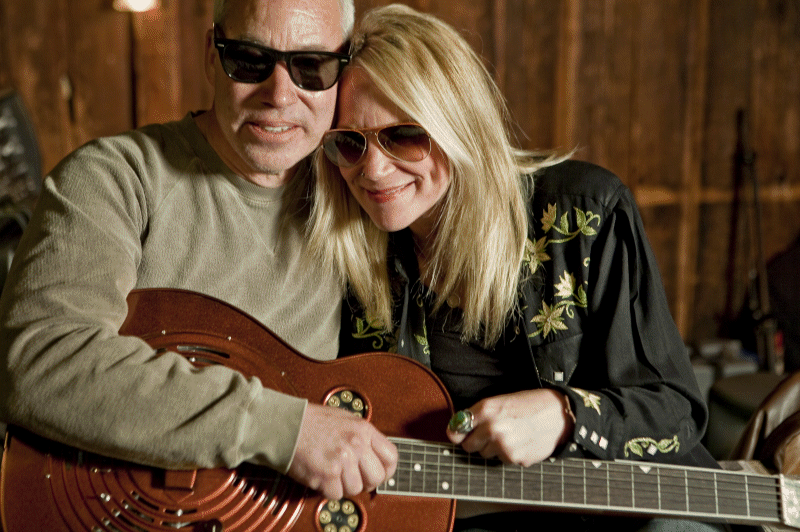
One hundred years ago, in 1916, the Martin Guitar Company manufactured a new model called a Dreadnought. The most obvious characteristic of the Dreadnought—to this day the most popular acoustic guitar style in America—was its larger body size, meant to help players in their efforts to be heard amidst the brass and percussive instruments that made up many popular ensembles of the day. Later, in the 1920s, a violin repairman named John Dopyera addressed the problem in a different way when he made the first resonator guitar for George Beauchamp, a Vaudeville lap steel guitar player from Texas. Rather than rely on the instrument’s wooden top and body to amplify the sound waves from the strings, Dopyera devised aluminum cones that received the string vibrations through a variety of combinations and configurations, producing a sound much louder and brighter than that of a traditional acoustic guitar. Dopyera and Beauchamp began manufacturing tri-cone, metal-bodied National Steel guitars in Los Angeles in 1927. A year later, Dopyera left to form his own company with his brothers, naming it Dobro Manufacturing, producing a single, larger resonator cone that sat inverted under a perforated metal cover plate. The Dopyera brothers were able to eventually combine both National and Dobro into one company, while Beauchamp, himself no slouch when it came to innovation, went on to achieve supreme audibility by developing the first electric guitars.
Today, the words Dobro or National Steel identify the resonator guitars commonly used in blues, bluegrass and country music. Really an entirely different instrument than the conventional derivation of the Spanish guitar, a resonator is often played flat on the musician’s lap, and almost always with a slide or bottleneck, with the strings usually set high off the fretboard. The sounds from those guitars are some of the expressive and memorable in American music.
It’s not hard to find a factory stamped, mass-produced resonator guitar. Were you in the market, however, for one of these amazing music machines, custom-made and tailored exactly to your tastes, you’d think that Nashville or Memphis would be good places to look. Or even Austin, Texas. But you’re best bet might be in Bridgewater, New Jersey, where Mark Simon makes both his home and the astonishing Terraplane resonator guitar.
Mark came of age in Livingston during the garage band era of the mid ‘60s, where his passion for guitars was equaled only by his love for British sports cars. Along with thousands of other budding suburban guitar players, he learned about the rich heritage of the instrument and the great guitar manufacturers—Gibson, Martin, Fender, Rickenbacker, and others—on trips to New York City music stores, where all the guitars heard on records and seen in magazines, awaited close-up inspection. Among the most respected shops was Mandolin Brothers, on Staten Island, which began in 1971 and quickly gained a reputation for dealing in vintage mandolins, banjos, ukuleles and guitars. “Stan Jay and Hap Kuffner created this great guitar shop in Hap’s apartment above a bank on Bay Street. It was the first Mandolin Brothers location. I was first there looking at mandolins in 1973,” says Mark, remembering the place where served as head of repair at age twenty-three, from 1976-1981. Simon’s forty-three year career as a luthier has taken him many places and laid his hands on thousands of instruments, including some of the most revered in Guitardom. Only the most skilled craftsman would be trusted to work on that first Ditson Dreadnought, made by Martin Guitar a century ago. (The guitar belonged to the esteemed collector, Scott Chinery.) Mark has also designed and built his own line of guitars, banjos and mandolins.
Twelve years ago, Mark decided to start building metal-bodied resonator guitars, partly because he saw a market but also because he was excited about using a new medium. “I think they stopped making great acoustic guitars in 1939. For some reason it just stopped,” says Mark. “I don’t know what it is, even when some of the these guys use the old wood, it’s gone. It died with the factory workers. They were not aware that they were making future collectibles. It was just their job, and they were really good at it. The wood has definitely changed, the finishes are different. Nitrocellouse lacquer has definitely changed with plasticizers, and who knows what else. It used to be more like shellac. They have not ruined shellac yet, which is still made from lac bug excrement scraped off leaves of trees. The environmental changes have taken away a lot of the tone woods. But even when using the correct older woods, hide glue, and all the mysterious tricks in acoustic instruments, myself included, its just not there. I feel these older guitars were always great, even when new. ”
In 1936, the great Robert Johnson recorded his first hit song called Terraplane Blues, referring to the popular “muscle car” of that era, built by the Hudson Motor Company. When the renowned contemporary guitarist, Arlen Roth, asked Simon to build him a resonator guitar with cover discs to resemble the hubcaps on his own classic Terraplane, the name became Mark’s brand too. Terraplane Guitars incorporate the acoustic qualities and tactile intricacies prized by virtuoso guitar players, packed into a gleaming, and handcrafted sculpture of wood and metal that reflects a rare combination of skills and sensibilities. When I ask him what he had to do to hand-make a resonator guitar without the benefit of factory presses, Mark looks at me like “Are you ready for this?”
The guitar body was relatively easy for Mark who, from years of working on his cars, had learned how to shape metal panels by hand. For its tonal elements and workability, Simon prefers brass instead of steel for Terraplanes. Emulating the skills employed by European post WWII auto body workers, who hand hammered smaller pieces of aluminum welded together to form a larger panel, he forms the guitar sides in two pieces formed over a table edge with hand pressure, “how Morgan used to and still hand forms panels for their cars.” The side panel, beaded on both edges, called a ‘wired edge’, is hand hammered over a brass wire. The back is hand hammered over a leather bag filled with birdshot, then English wheeled to planish all the walnut size bumps out.
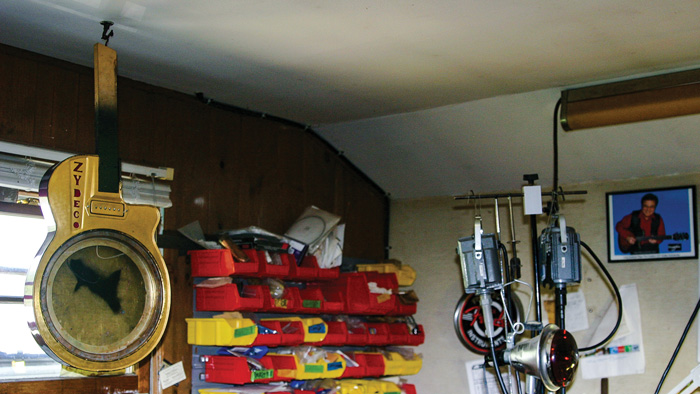
To hold the aluminum resonator cone, a circular piece is first metal spun on a lathe to create a first step, then pressed into a created set of steel dies to create a second, deeper step. This cone receiver is then silver soldered to the underside of the top. Early Nationals had the top with all the cut outs, the cone receiver and the sides formed in one piece, probably in less than a minute.
Terraplanes employ a dobro-style spider bridge that sends string vibrations from the bridge saddle to numerous points around the cone, both the center and along the edges. Mark uses factory aluminum spiders in the higher action square neck (lap style) guitars. However, he did not like they way they were sounding in the lower action round neck guitars and set out to create his own spider with carbon fiber. Aluminum factory spiders are sand-cast. Simon’s spiders are hand placed threads of carbon fiber and epoxy placed in a specially made mold.
“First I had to buy the equipment; I didn’t even know if it would work,” says Mark. The mold is vacuum bagged and all the air and excess epoxy is removed, “I bought a vacuum pump and hooked up pressure sensing controls that turn the pump on when the air pressure falls to a pre-set low point. This way the pump does not have to run for twelve hours straight until the epoxy cures. The pump will cycle maybe once every half hour for thirty seconds. I installed a blow off valve so nothing can explode. It can take up to three days to make a single spider. I have two different styles. But the carbon fiber is very strong stuff, very quick in transmitting tone, much faster than aluminum, and, it’s one-third the weight of aluminum. It’s a big selling point. Articulation between single notes is like nothing ever before heard. The Terraplane has it’s own unique sound. It’s not a copy of anything ever built before.”
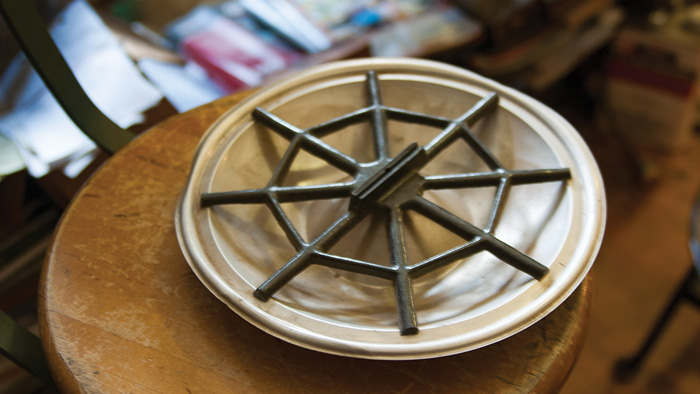
The resonator cone acts like a typical loudspeaker, sending higher frequencies off the top of the cone, out the vented top cover. In the Terraplane, the cutout name in the front panel act as the bass port. Simon cut the original by hand, based on the logo font used on the automobile. He has since purchased a pantograph that was used to engrave bombshells in World War II to guide a milling head to cut out the Terraplane, as well as logos on the Zydeco, and Pneumatic Transit models. Lower frequencies come off the cone’s back and around through sound ports on the .44 Special models. The front panels for the .44 Special sound ports are made with a set of dies with a bolt connecting them together. When tightened it forms the raised area around the sound hole. “I got lucky with the punch for the sound hole. It was commercially available and the size I was looking for: the only off the shelf tool that was purchased.”
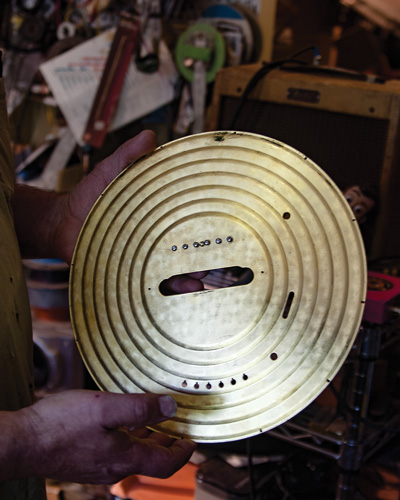
The cover anchors the guitar strings and holds a magnetic pick-up at a precise distance above the resonator assembly. “Everybody else uses Dobro’s or National’s cover, which you can buy for $50. The ridges on the Terraplane hubcap cover are my take on how to go from zero to half an inch without stamping the piece in a 200,000 dollar and ton press,” explains Mark. “It took me two years to figure it out. The first thing I had to do is stop throwing away brass, I mean sheets and sheets of it.” He picks up a cover prototype to illustrate. “I started with a 4 x 6 sheet, cut oversize squares, band-sawed a rough circle, punched a hole in the center and mounted it on an aluminum form on a lathe. As it spins, you push against an aluminum form with a ball bearing mounted on an arm in the tool holder, and it comes back at you with all the edges ruffled. Then you have to heat it up again, change the die, push it from the opposite side with another form, and repeat. The piece gets smaller as you press each ridge; there was a lot of trial and error to get the precise diameter with the correct height. I’m finishing all covers, the whole top on a Zydeco, in 24 karat gold leaf”.
Mark’s education in metal work continued as he learned to fabricate other components. Terraplanes use custom-wound pickups from Jason Lollar, a supplier from Seattle. But the pickup cover, which looks quite simple, like the inside sliding part of a matchbox, comes from another six months of Mark’s education in metal work. “I found an old book from right after the Civil War that explained how early pieces were pressed. I make these in a small hydraulic press; it took a long time to get the right tolerances.” The cover helps shield the pick-up from outside noise, providing the most realistic and reliable amplification of the resonators sound in any stage situation. Plus, it looks better.

The quest for optimal performance induced Mark to also co-invent a companion electronic “squeal killer box” for magnetic pickups, which contains an electronic circuit switch which shuts down when it senses acoustic feedback, then reopens the circuit at speeds so fast you can’t tell what is taking place. It gives the player one third more headroom in gain without feedback. There are also several complementary Terraplane amplifiers, voiced specifically for these guitars. “Leo Fender did it,” says Simon. “I figured I’d do it too!”
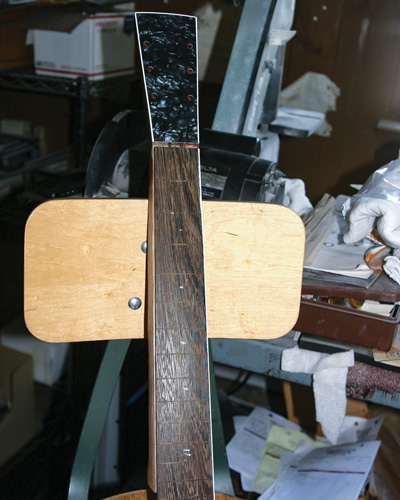
Mark fashions the guitar necks in a traditional look from Spanish cedar—flat for lap or round for vertical playing. Instead of a truss rod, the necks are reinforced with three carbon strips—lighter, stronger, and which transmit tone better with no dead spots. For the fingerboard, he resaws three-inch-wide strips of Wenge wood, then shapes them to the neck’s top radius through a molding cutter. The necks are drilled and bolted to the body with the aid of a special sheet metal box, soldered under the top, another invention from Simon’s metal shop.
Terraplane guitars come in all sorts of configurations, with variations in necks, cones, pick-ups, decorative features and finish. The Zydeco is a smaller bodied version of the original Terraplane. The .44 Special comes without the cutaway body, and real .44 Special shell casings that move up and down to close the ports when the player needs to reduce feedback. “It voices the guitars resonate body frequency, like a bass reflex port in a speaker cabinet.” You can get anything you want, but you’re going to have to wait. Mark keeps very busy with his guitar repair business and cranks out two Terraplanes each year. Sign up now!
